Financial Accounting Report: Regulations, Statements, and Ratios
VerifiedAdded on 2020/02/05
|23
|4466
|207
Report
AI Summary
This report delves into the core concepts of financial accounting, providing a comprehensive overview of its principles and practices. It begins by identifying the diverse users of financial statements and their respective information needs, emphasizing the importance of financial stability and growth indicators. The report then explores the legal and regulatory influences on financial statements, including key legislation like the Companies Act 2006, and accounting standards such as IFRS and GAAP, highlighting their implications for users. Furthermore, the report examines the role of regulatory bodies and how different laws and regulations shape accounting and reporting standards. The report also provides a practical application of accounting principles through the preparation of financial statements from a trial balance and addresses the preparation of financial statements from incomplete records. Finally, the report concludes with an analysis of accounting ratios to assess the performance and position of a business, offering valuable insights into financial statement analysis.
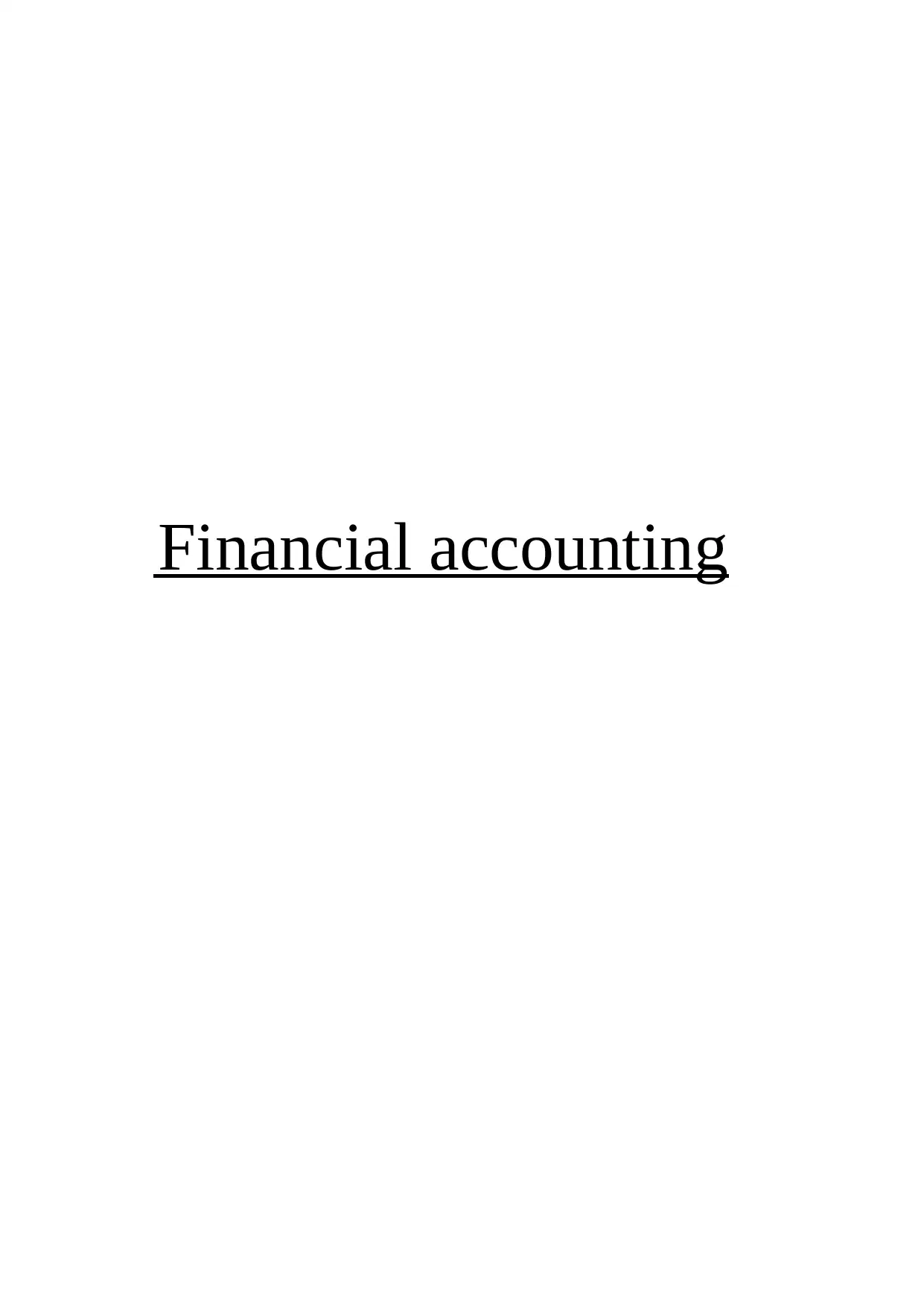
Financial accounting
Paraphrase This Document
Need a fresh take? Get an instant paraphrase of this document with our AI Paraphraser
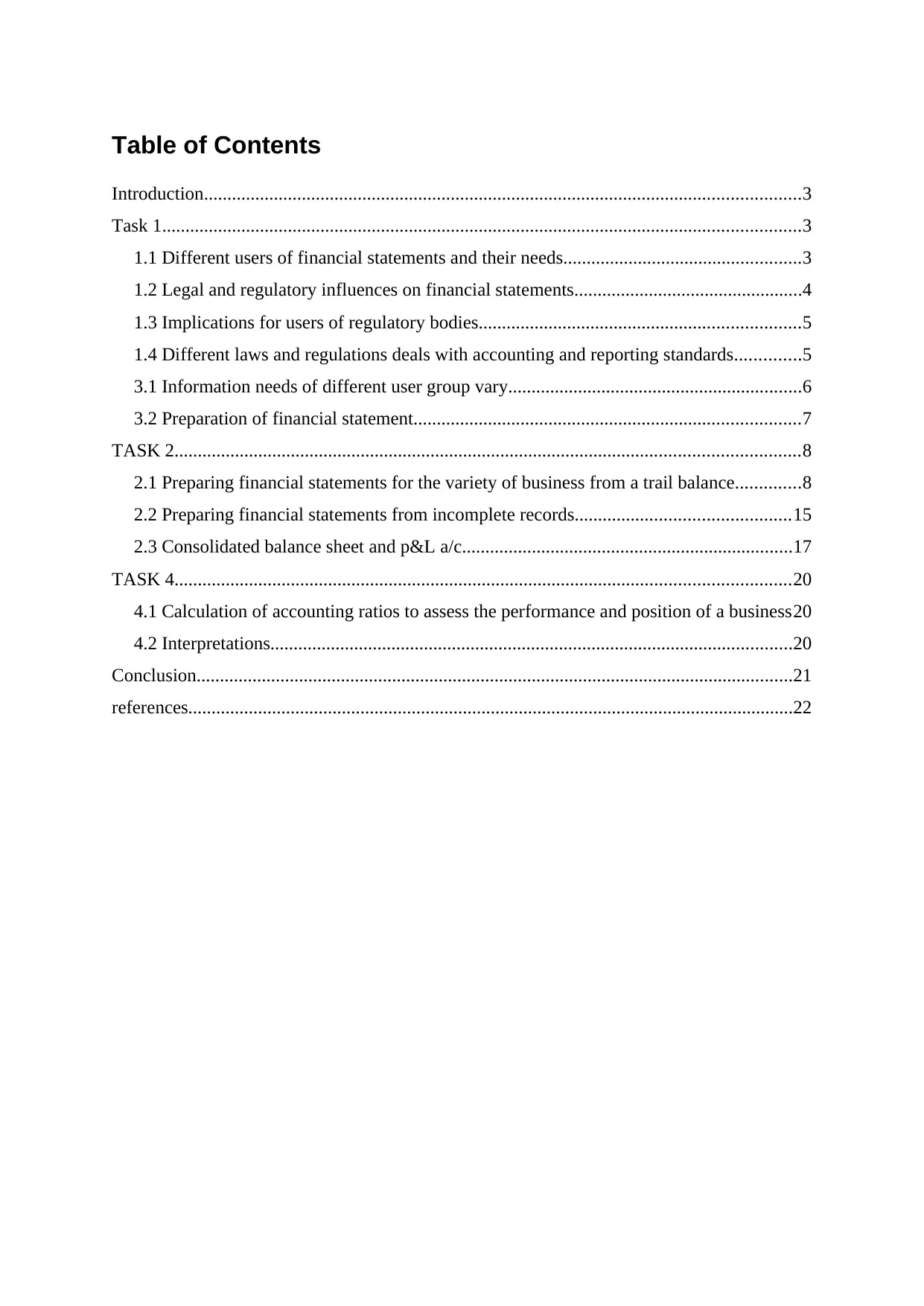
Table of Contents
Introduction................................................................................................................................3
Task 1.........................................................................................................................................3
1.1 Different users of financial statements and their needs...................................................3
1.2 Legal and regulatory influences on financial statements.................................................4
1.3 Implications for users of regulatory bodies.....................................................................5
1.4 Different laws and regulations deals with accounting and reporting standards..............5
3.1 Information needs of different user group vary...............................................................6
3.2 Preparation of financial statement...................................................................................7
TASK 2......................................................................................................................................8
2.1 Preparing financial statements for the variety of business from a trail balance..............8
2.2 Preparing financial statements from incomplete records..............................................15
2.3 Consolidated balance sheet and p&L a/c.......................................................................17
TASK 4....................................................................................................................................20
4.1 Calculation of accounting ratios to assess the performance and position of a business20
4.2 Interpretations................................................................................................................20
Conclusion................................................................................................................................21
references..................................................................................................................................22
Introduction................................................................................................................................3
Task 1.........................................................................................................................................3
1.1 Different users of financial statements and their needs...................................................3
1.2 Legal and regulatory influences on financial statements.................................................4
1.3 Implications for users of regulatory bodies.....................................................................5
1.4 Different laws and regulations deals with accounting and reporting standards..............5
3.1 Information needs of different user group vary...............................................................6
3.2 Preparation of financial statement...................................................................................7
TASK 2......................................................................................................................................8
2.1 Preparing financial statements for the variety of business from a trail balance..............8
2.2 Preparing financial statements from incomplete records..............................................15
2.3 Consolidated balance sheet and p&L a/c.......................................................................17
TASK 4....................................................................................................................................20
4.1 Calculation of accounting ratios to assess the performance and position of a business20
4.2 Interpretations................................................................................................................20
Conclusion................................................................................................................................21
references..................................................................................................................................22
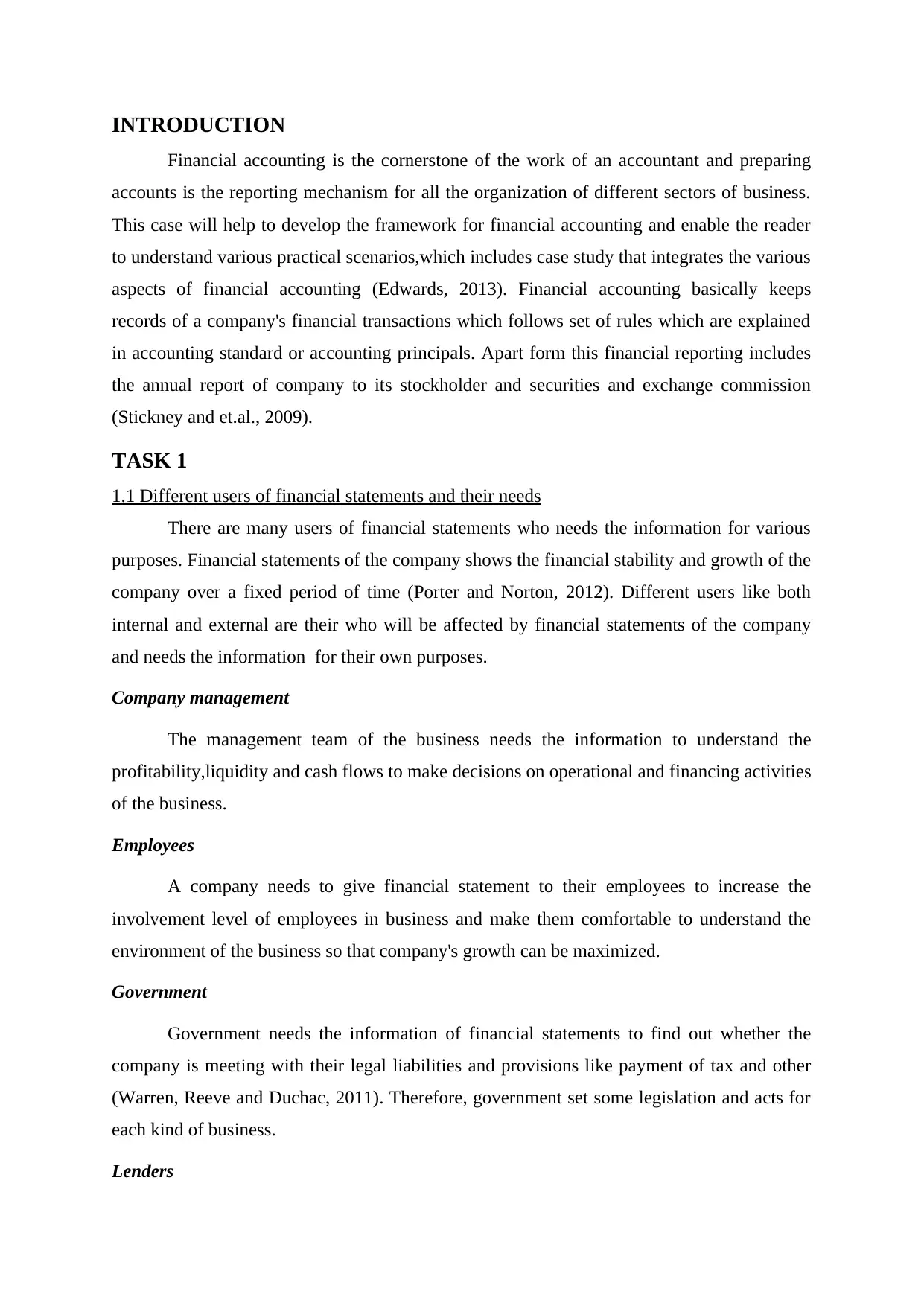
INTRODUCTION
Financial accounting is the cornerstone of the work of an accountant and preparing
accounts is the reporting mechanism for all the organization of different sectors of business.
This case will help to develop the framework for financial accounting and enable the reader
to understand various practical scenarios,which includes case study that integrates the various
aspects of financial accounting (Edwards, 2013). Financial accounting basically keeps
records of a company's financial transactions which follows set of rules which are explained
in accounting standard or accounting principals. Apart form this financial reporting includes
the annual report of company to its stockholder and securities and exchange commission
(Stickney and et.al., 2009).
TASK 1
1.1 Different users of financial statements and their needs
There are many users of financial statements who needs the information for various
purposes. Financial statements of the company shows the financial stability and growth of the
company over a fixed period of time (Porter and Norton, 2012). Different users like both
internal and external are their who will be affected by financial statements of the company
and needs the information for their own purposes.
Company management
The management team of the business needs the information to understand the
profitability,liquidity and cash flows to make decisions on operational and financing activities
of the business.
Employees
A company needs to give financial statement to their employees to increase the
involvement level of employees in business and make them comfortable to understand the
environment of the business so that company's growth can be maximized.
Government
Government needs the information of financial statements to find out whether the
company is meeting with their legal liabilities and provisions like payment of tax and other
(Warren, Reeve and Duchac, 2011). Therefore, government set some legislation and acts for
each kind of business.
Lenders
Financial accounting is the cornerstone of the work of an accountant and preparing
accounts is the reporting mechanism for all the organization of different sectors of business.
This case will help to develop the framework for financial accounting and enable the reader
to understand various practical scenarios,which includes case study that integrates the various
aspects of financial accounting (Edwards, 2013). Financial accounting basically keeps
records of a company's financial transactions which follows set of rules which are explained
in accounting standard or accounting principals. Apart form this financial reporting includes
the annual report of company to its stockholder and securities and exchange commission
(Stickney and et.al., 2009).
TASK 1
1.1 Different users of financial statements and their needs
There are many users of financial statements who needs the information for various
purposes. Financial statements of the company shows the financial stability and growth of the
company over a fixed period of time (Porter and Norton, 2012). Different users like both
internal and external are their who will be affected by financial statements of the company
and needs the information for their own purposes.
Company management
The management team of the business needs the information to understand the
profitability,liquidity and cash flows to make decisions on operational and financing activities
of the business.
Employees
A company needs to give financial statement to their employees to increase the
involvement level of employees in business and make them comfortable to understand the
environment of the business so that company's growth can be maximized.
Government
Government needs the information of financial statements to find out whether the
company is meeting with their legal liabilities and provisions like payment of tax and other
(Warren, Reeve and Duchac, 2011). Therefore, government set some legislation and acts for
each kind of business.
Lenders
⊘ This is a preview!⊘
Do you want full access?
Subscribe today to unlock all pages.

Trusted by 1+ million students worldwide
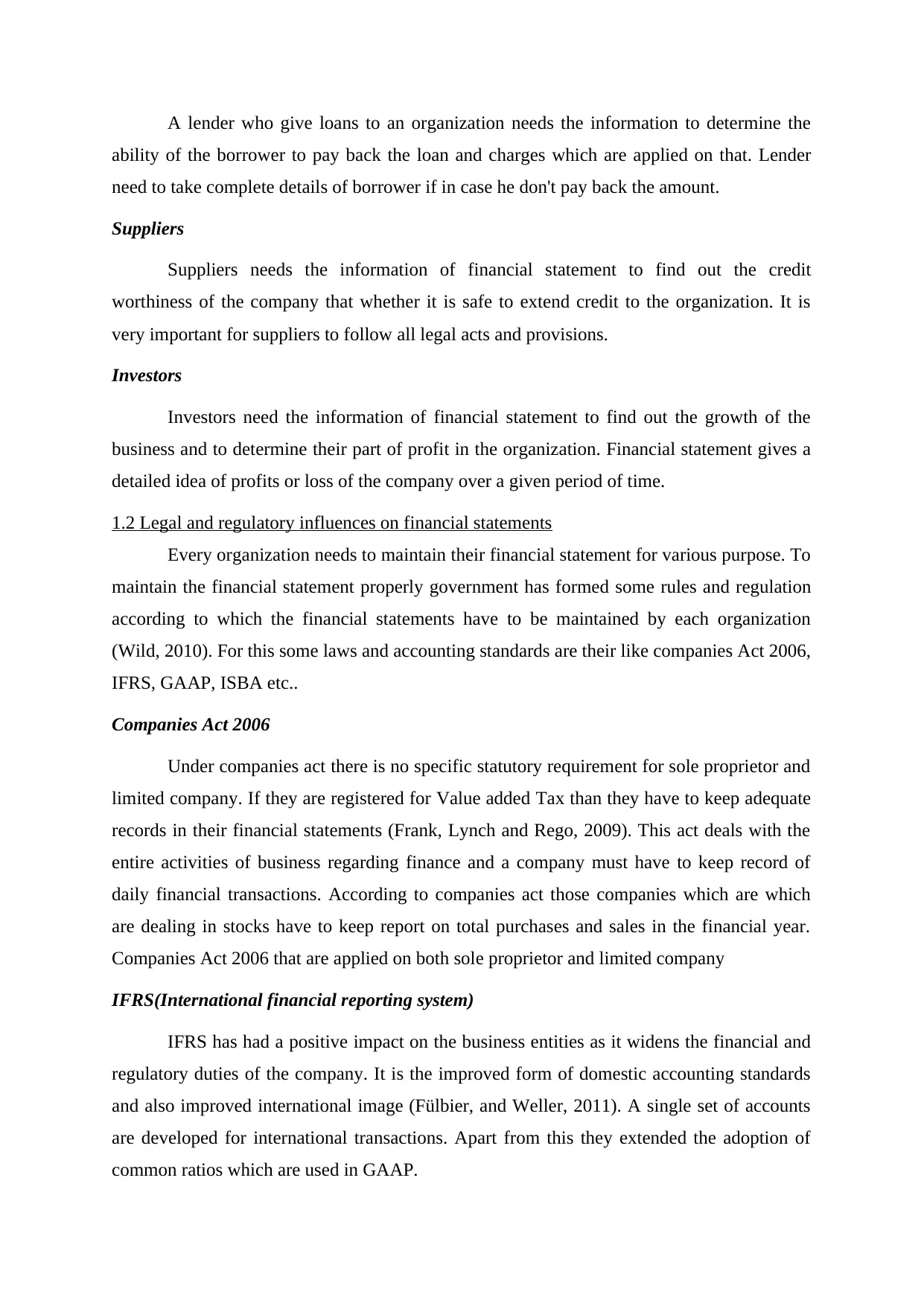
A lender who give loans to an organization needs the information to determine the
ability of the borrower to pay back the loan and charges which are applied on that. Lender
need to take complete details of borrower if in case he don't pay back the amount.
Suppliers
Suppliers needs the information of financial statement to find out the credit
worthiness of the company that whether it is safe to extend credit to the organization. It is
very important for suppliers to follow all legal acts and provisions.
Investors
Investors need the information of financial statement to find out the growth of the
business and to determine their part of profit in the organization. Financial statement gives a
detailed idea of profits or loss of the company over a given period of time.
1.2 Legal and regulatory influences on financial statements
Every organization needs to maintain their financial statement for various purpose. To
maintain the financial statement properly government has formed some rules and regulation
according to which the financial statements have to be maintained by each organization
(Wild, 2010). For this some laws and accounting standards are their like companies Act 2006,
IFRS, GAAP, ISBA etc..
Companies Act 2006
Under companies act there is no specific statutory requirement for sole proprietor and
limited company. If they are registered for Value added Tax than they have to keep adequate
records in their financial statements (Frank, Lynch and Rego, 2009). This act deals with the
entire activities of business regarding finance and a company must have to keep record of
daily financial transactions. According to companies act those companies which are which
are dealing in stocks have to keep report on total purchases and sales in the financial year.
Companies Act 2006 that are applied on both sole proprietor and limited company
IFRS(International financial reporting system)
IFRS has had a positive impact on the business entities as it widens the financial and
regulatory duties of the company. It is the improved form of domestic accounting standards
and also improved international image (Fülbier, and Weller, 2011). A single set of accounts
are developed for international transactions. Apart from this they extended the adoption of
common ratios which are used in GAAP.
ability of the borrower to pay back the loan and charges which are applied on that. Lender
need to take complete details of borrower if in case he don't pay back the amount.
Suppliers
Suppliers needs the information of financial statement to find out the credit
worthiness of the company that whether it is safe to extend credit to the organization. It is
very important for suppliers to follow all legal acts and provisions.
Investors
Investors need the information of financial statement to find out the growth of the
business and to determine their part of profit in the organization. Financial statement gives a
detailed idea of profits or loss of the company over a given period of time.
1.2 Legal and regulatory influences on financial statements
Every organization needs to maintain their financial statement for various purpose. To
maintain the financial statement properly government has formed some rules and regulation
according to which the financial statements have to be maintained by each organization
(Wild, 2010). For this some laws and accounting standards are their like companies Act 2006,
IFRS, GAAP, ISBA etc..
Companies Act 2006
Under companies act there is no specific statutory requirement for sole proprietor and
limited company. If they are registered for Value added Tax than they have to keep adequate
records in their financial statements (Frank, Lynch and Rego, 2009). This act deals with the
entire activities of business regarding finance and a company must have to keep record of
daily financial transactions. According to companies act those companies which are which
are dealing in stocks have to keep report on total purchases and sales in the financial year.
Companies Act 2006 that are applied on both sole proprietor and limited company
IFRS(International financial reporting system)
IFRS has had a positive impact on the business entities as it widens the financial and
regulatory duties of the company. It is the improved form of domestic accounting standards
and also improved international image (Fülbier, and Weller, 2011). A single set of accounts
are developed for international transactions. Apart from this they extended the adoption of
common ratios which are used in GAAP.
Paraphrase This Document
Need a fresh take? Get an instant paraphrase of this document with our AI Paraphraser
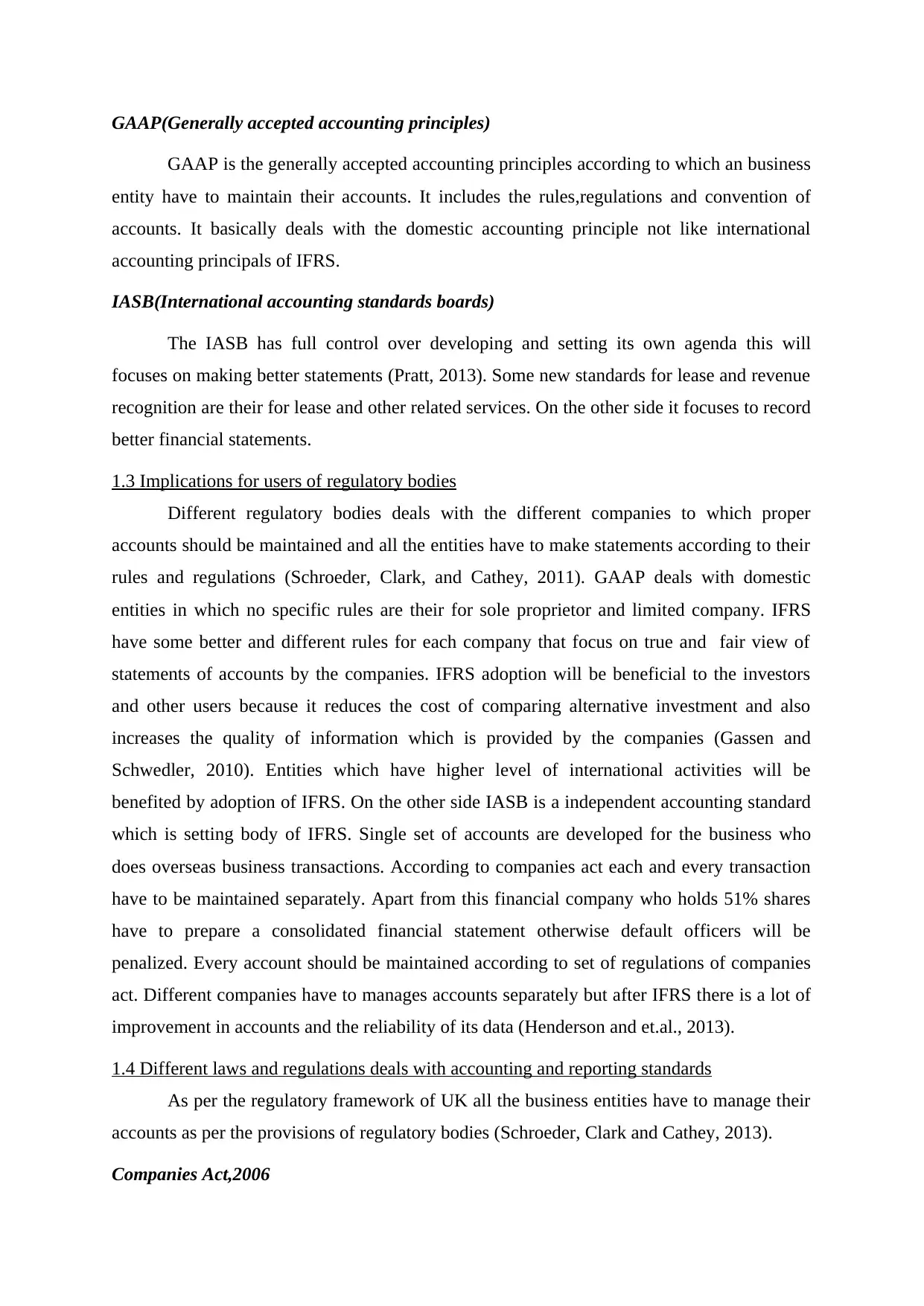
GAAP(Generally accepted accounting principles)
GAAP is the generally accepted accounting principles according to which an business
entity have to maintain their accounts. It includes the rules,regulations and convention of
accounts. It basically deals with the domestic accounting principle not like international
accounting principals of IFRS.
IASB(International accounting standards boards)
The IASB has full control over developing and setting its own agenda this will
focuses on making better statements (Pratt, 2013). Some new standards for lease and revenue
recognition are their for lease and other related services. On the other side it focuses to record
better financial statements.
1.3 Implications for users of regulatory bodies
Different regulatory bodies deals with the different companies to which proper
accounts should be maintained and all the entities have to make statements according to their
rules and regulations (Schroeder, Clark, and Cathey, 2011). GAAP deals with domestic
entities in which no specific rules are their for sole proprietor and limited company. IFRS
have some better and different rules for each company that focus on true and fair view of
statements of accounts by the companies. IFRS adoption will be beneficial to the investors
and other users because it reduces the cost of comparing alternative investment and also
increases the quality of information which is provided by the companies (Gassen and
Schwedler, 2010). Entities which have higher level of international activities will be
benefited by adoption of IFRS. On the other side IASB is a independent accounting standard
which is setting body of IFRS. Single set of accounts are developed for the business who
does overseas business transactions. According to companies act each and every transaction
have to be maintained separately. Apart from this financial company who holds 51% shares
have to prepare a consolidated financial statement otherwise default officers will be
penalized. Every account should be maintained according to set of regulations of companies
act. Different companies have to manages accounts separately but after IFRS there is a lot of
improvement in accounts and the reliability of its data (Henderson and et.al., 2013).
1.4 Different laws and regulations deals with accounting and reporting standards
As per the regulatory framework of UK all the business entities have to manage their
accounts as per the provisions of regulatory bodies (Schroeder, Clark and Cathey, 2013).
Companies Act,2006
GAAP is the generally accepted accounting principles according to which an business
entity have to maintain their accounts. It includes the rules,regulations and convention of
accounts. It basically deals with the domestic accounting principle not like international
accounting principals of IFRS.
IASB(International accounting standards boards)
The IASB has full control over developing and setting its own agenda this will
focuses on making better statements (Pratt, 2013). Some new standards for lease and revenue
recognition are their for lease and other related services. On the other side it focuses to record
better financial statements.
1.3 Implications for users of regulatory bodies
Different regulatory bodies deals with the different companies to which proper
accounts should be maintained and all the entities have to make statements according to their
rules and regulations (Schroeder, Clark, and Cathey, 2011). GAAP deals with domestic
entities in which no specific rules are their for sole proprietor and limited company. IFRS
have some better and different rules for each company that focus on true and fair view of
statements of accounts by the companies. IFRS adoption will be beneficial to the investors
and other users because it reduces the cost of comparing alternative investment and also
increases the quality of information which is provided by the companies (Gassen and
Schwedler, 2010). Entities which have higher level of international activities will be
benefited by adoption of IFRS. On the other side IASB is a independent accounting standard
which is setting body of IFRS. Single set of accounts are developed for the business who
does overseas business transactions. According to companies act each and every transaction
have to be maintained separately. Apart from this financial company who holds 51% shares
have to prepare a consolidated financial statement otherwise default officers will be
penalized. Every account should be maintained according to set of regulations of companies
act. Different companies have to manages accounts separately but after IFRS there is a lot of
improvement in accounts and the reliability of its data (Henderson and et.al., 2013).
1.4 Different laws and regulations deals with accounting and reporting standards
As per the regulatory framework of UK all the business entities have to manage their
accounts as per the provisions of regulatory bodies (Schroeder, Clark and Cathey, 2013).
Companies Act,2006
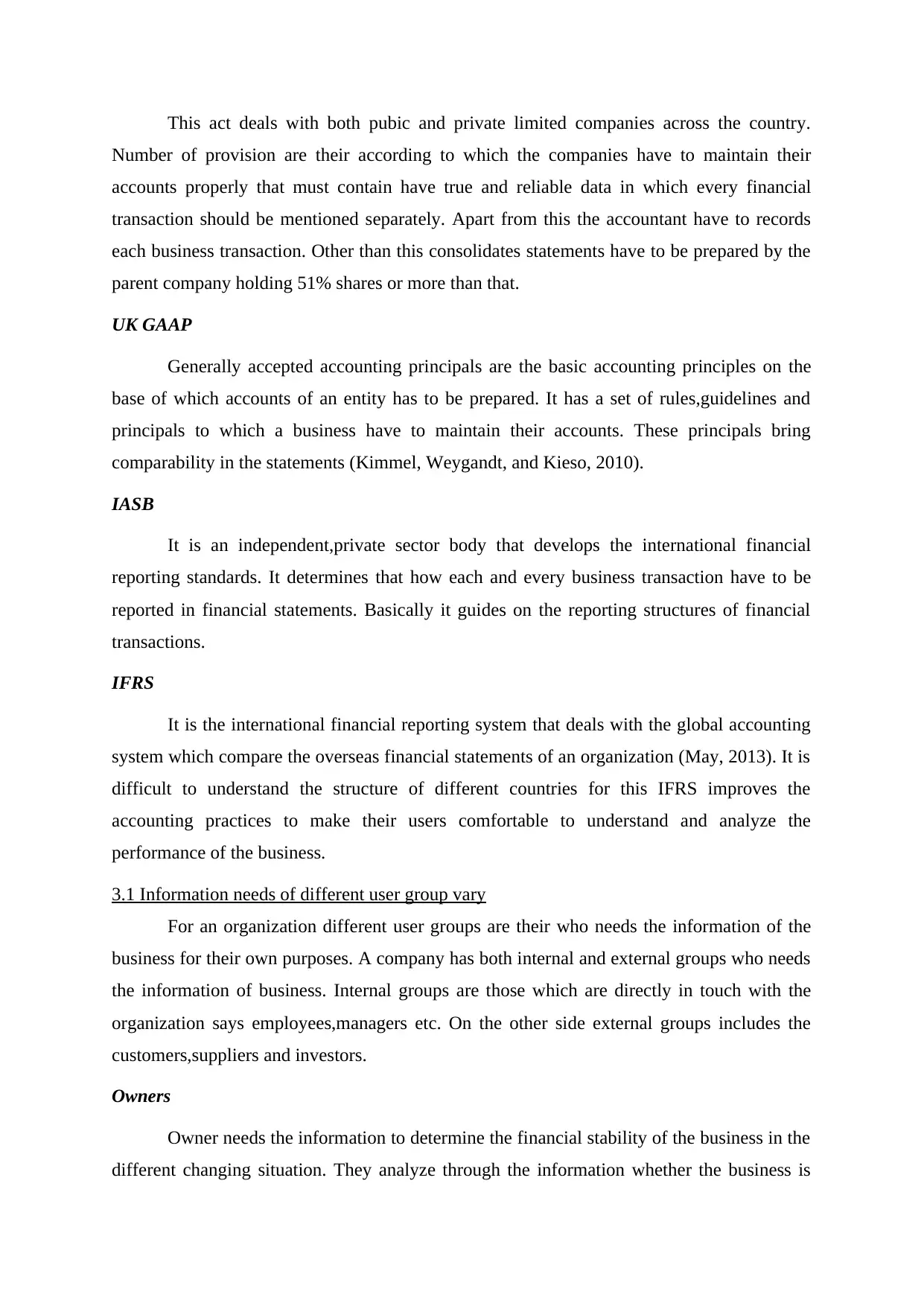
This act deals with both pubic and private limited companies across the country.
Number of provision are their according to which the companies have to maintain their
accounts properly that must contain have true and reliable data in which every financial
transaction should be mentioned separately. Apart from this the accountant have to records
each business transaction. Other than this consolidates statements have to be prepared by the
parent company holding 51% shares or more than that.
UK GAAP
Generally accepted accounting principals are the basic accounting principles on the
base of which accounts of an entity has to be prepared. It has a set of rules,guidelines and
principals to which a business have to maintain their accounts. These principals bring
comparability in the statements (Kimmel, Weygandt, and Kieso, 2010).
IASB
It is an independent,private sector body that develops the international financial
reporting standards. It determines that how each and every business transaction have to be
reported in financial statements. Basically it guides on the reporting structures of financial
transactions.
IFRS
It is the international financial reporting system that deals with the global accounting
system which compare the overseas financial statements of an organization (May, 2013). It is
difficult to understand the structure of different countries for this IFRS improves the
accounting practices to make their users comfortable to understand and analyze the
performance of the business.
3.1 Information needs of different user group vary
For an organization different user groups are their who needs the information of the
business for their own purposes. A company has both internal and external groups who needs
the information of business. Internal groups are those which are directly in touch with the
organization says employees,managers etc. On the other side external groups includes the
customers,suppliers and investors.
Owners
Owner needs the information to determine the financial stability of the business in the
different changing situation. They analyze through the information whether the business is
Number of provision are their according to which the companies have to maintain their
accounts properly that must contain have true and reliable data in which every financial
transaction should be mentioned separately. Apart from this the accountant have to records
each business transaction. Other than this consolidates statements have to be prepared by the
parent company holding 51% shares or more than that.
UK GAAP
Generally accepted accounting principals are the basic accounting principles on the
base of which accounts of an entity has to be prepared. It has a set of rules,guidelines and
principals to which a business have to maintain their accounts. These principals bring
comparability in the statements (Kimmel, Weygandt, and Kieso, 2010).
IASB
It is an independent,private sector body that develops the international financial
reporting standards. It determines that how each and every business transaction have to be
reported in financial statements. Basically it guides on the reporting structures of financial
transactions.
IFRS
It is the international financial reporting system that deals with the global accounting
system which compare the overseas financial statements of an organization (May, 2013). It is
difficult to understand the structure of different countries for this IFRS improves the
accounting practices to make their users comfortable to understand and analyze the
performance of the business.
3.1 Information needs of different user group vary
For an organization different user groups are their who needs the information of the
business for their own purposes. A company has both internal and external groups who needs
the information of business. Internal groups are those which are directly in touch with the
organization says employees,managers etc. On the other side external groups includes the
customers,suppliers and investors.
Owners
Owner needs the information to determine the financial stability of the business in the
different changing situation. They analyze through the information whether the business is
⊘ This is a preview!⊘
Do you want full access?
Subscribe today to unlock all pages.

Trusted by 1+ million students worldwide
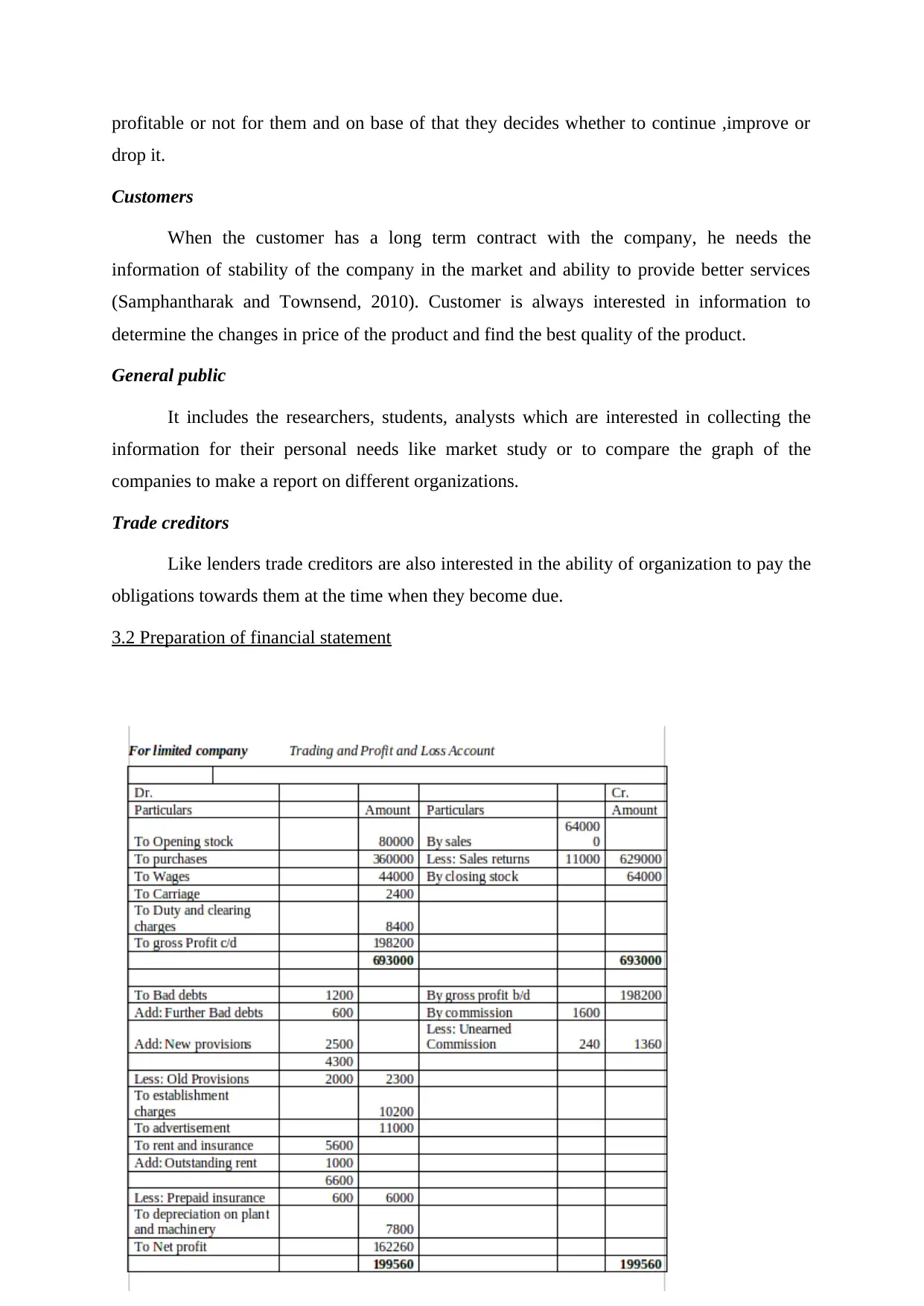
profitable or not for them and on base of that they decides whether to continue ,improve or
drop it.
Customers
When the customer has a long term contract with the company, he needs the
information of stability of the company in the market and ability to provide better services
(Samphantharak and Townsend, 2010). Customer is always interested in information to
determine the changes in price of the product and find the best quality of the product.
General public
It includes the researchers, students, analysts which are interested in collecting the
information for their personal needs like market study or to compare the graph of the
companies to make a report on different organizations.
Trade creditors
Like lenders trade creditors are also interested in the ability of organization to pay the
obligations towards them at the time when they become due.
3.2 Preparation of financial statement
drop it.
Customers
When the customer has a long term contract with the company, he needs the
information of stability of the company in the market and ability to provide better services
(Samphantharak and Townsend, 2010). Customer is always interested in information to
determine the changes in price of the product and find the best quality of the product.
General public
It includes the researchers, students, analysts which are interested in collecting the
information for their personal needs like market study or to compare the graph of the
companies to make a report on different organizations.
Trade creditors
Like lenders trade creditors are also interested in the ability of organization to pay the
obligations towards them at the time when they become due.
3.2 Preparation of financial statement
Paraphrase This Document
Need a fresh take? Get an instant paraphrase of this document with our AI Paraphraser
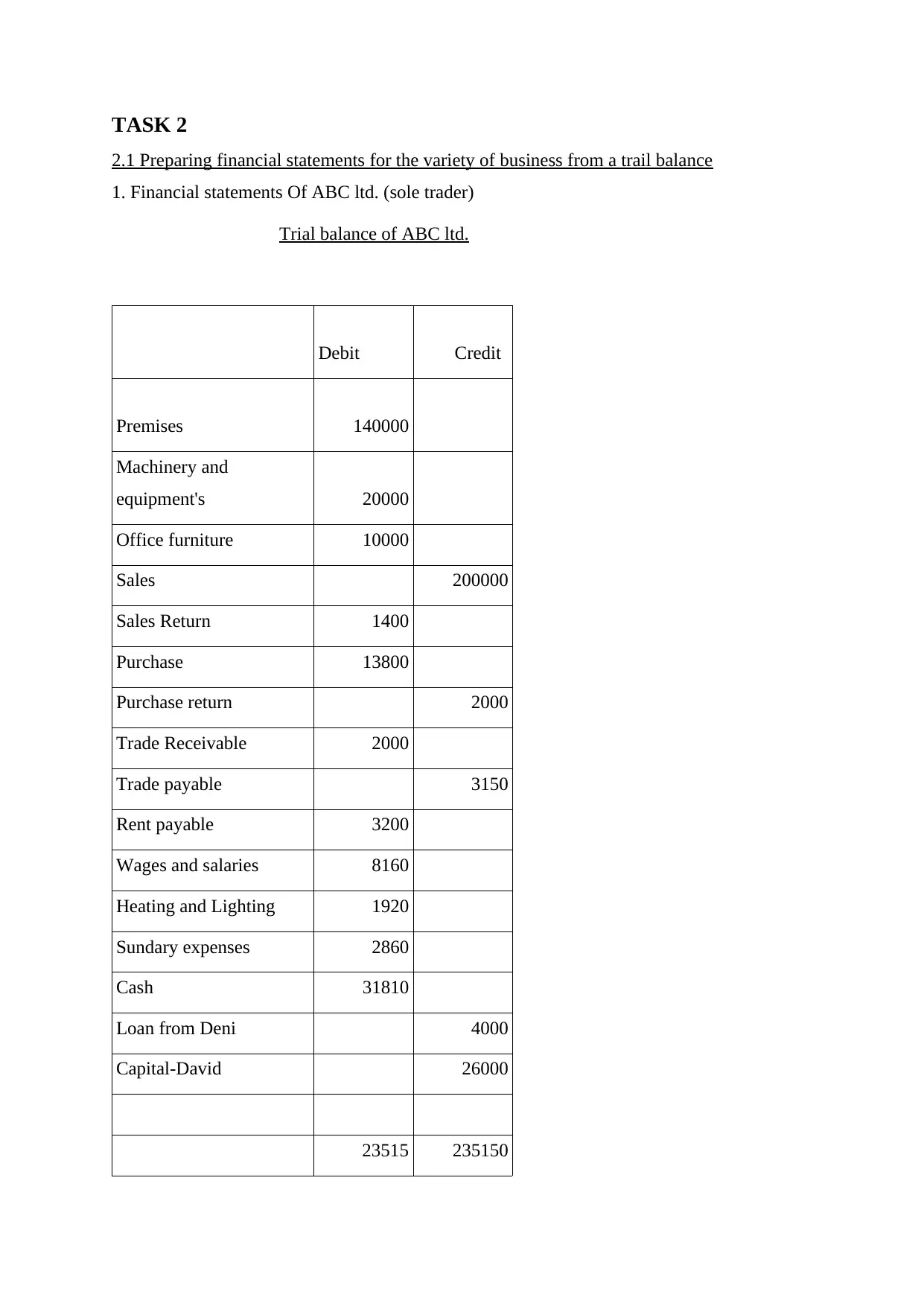
TASK 2
2.1 Preparing financial statements for the variety of business from a trail balance
1. Financial statements Of ABC ltd. (sole trader)
Trial balance of ABC ltd.
Debit Credit
Premises 140000
Machinery and
equipment's 20000
Office furniture 10000
Sales 200000
Sales Return 1400
Purchase 13800
Purchase return 2000
Trade Receivable 2000
Trade payable 3150
Rent payable 3200
Wages and salaries 8160
Heating and Lighting 1920
Sundary expenses 2860
Cash 31810
Loan from Deni 4000
Capital-David 26000
23515 235150
2.1 Preparing financial statements for the variety of business from a trail balance
1. Financial statements Of ABC ltd. (sole trader)
Trial balance of ABC ltd.
Debit Credit
Premises 140000
Machinery and
equipment's 20000
Office furniture 10000
Sales 200000
Sales Return 1400
Purchase 13800
Purchase return 2000
Trade Receivable 2000
Trade payable 3150
Rent payable 3200
Wages and salaries 8160
Heating and Lighting 1920
Sundary expenses 2860
Cash 31810
Loan from Deni 4000
Capital-David 26000
23515 235150
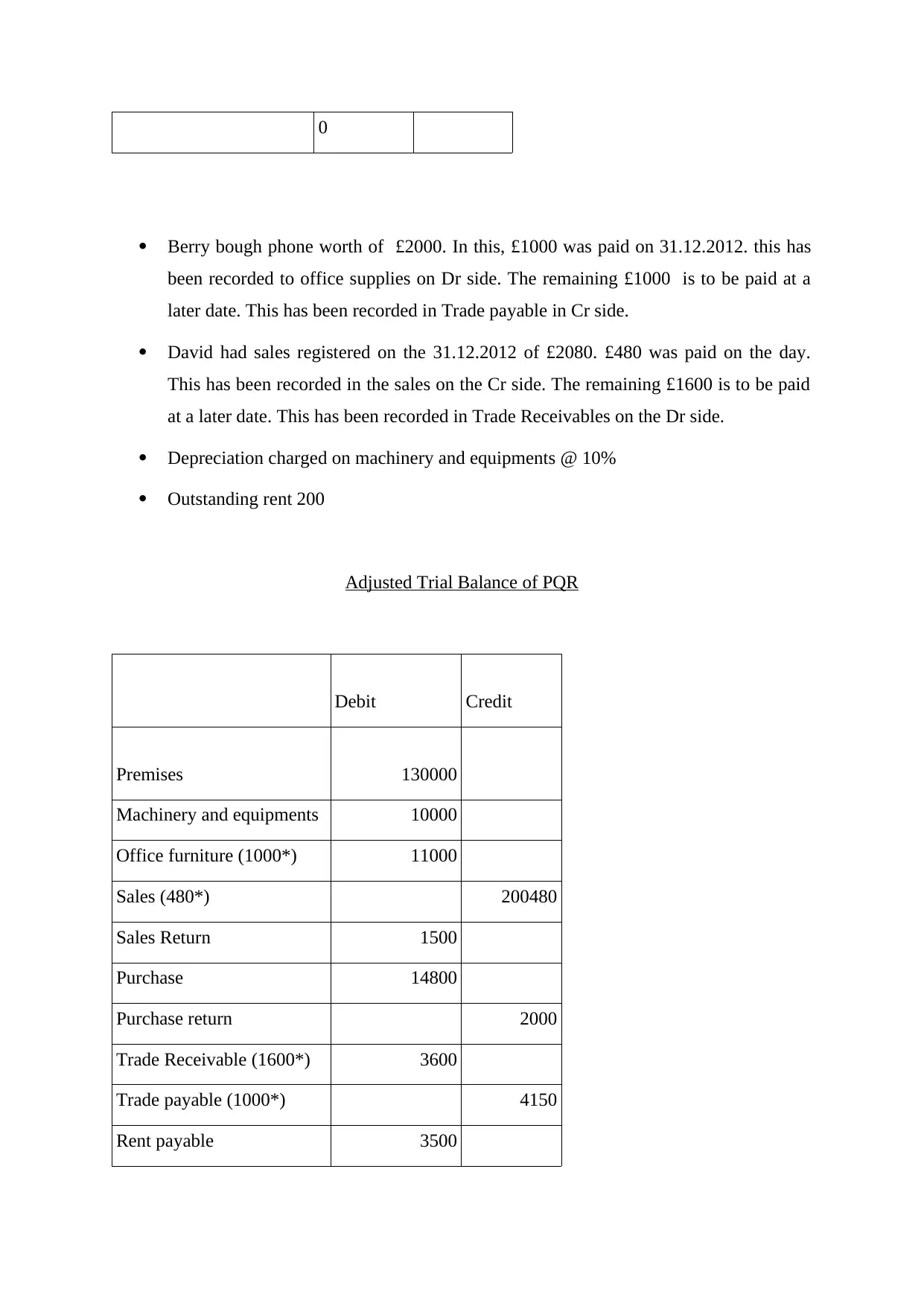
0
Berry bough phone worth of £2000. In this, £1000 was paid on 31.12.2012. this has
been recorded to office supplies on Dr side. The remaining £1000 is to be paid at a
later date. This has been recorded in Trade payable in Cr side.
David had sales registered on the 31.12.2012 of £2080. £480 was paid on the day.
This has been recorded in the sales on the Cr side. The remaining £1600 is to be paid
at a later date. This has been recorded in Trade Receivables on the Dr side.
Depreciation charged on machinery and equipments @ 10%
Outstanding rent 200
Adjusted Trial Balance of PQR
Debit Credit
Premises 130000
Machinery and equipments 10000
Office furniture (1000*) 11000
Sales (480*) 200480
Sales Return 1500
Purchase 14800
Purchase return 2000
Trade Receivable (1600*) 3600
Trade payable (1000*) 4150
Rent payable 3500
Berry bough phone worth of £2000. In this, £1000 was paid on 31.12.2012. this has
been recorded to office supplies on Dr side. The remaining £1000 is to be paid at a
later date. This has been recorded in Trade payable in Cr side.
David had sales registered on the 31.12.2012 of £2080. £480 was paid on the day.
This has been recorded in the sales on the Cr side. The remaining £1600 is to be paid
at a later date. This has been recorded in Trade Receivables on the Dr side.
Depreciation charged on machinery and equipments @ 10%
Outstanding rent 200
Adjusted Trial Balance of PQR
Debit Credit
Premises 130000
Machinery and equipments 10000
Office furniture (1000*) 11000
Sales (480*) 200480
Sales Return 1500
Purchase 14800
Purchase return 2000
Trade Receivable (1600*) 3600
Trade payable (1000*) 4150
Rent payable 3500
⊘ This is a preview!⊘
Do you want full access?
Subscribe today to unlock all pages.

Trusted by 1+ million students worldwide
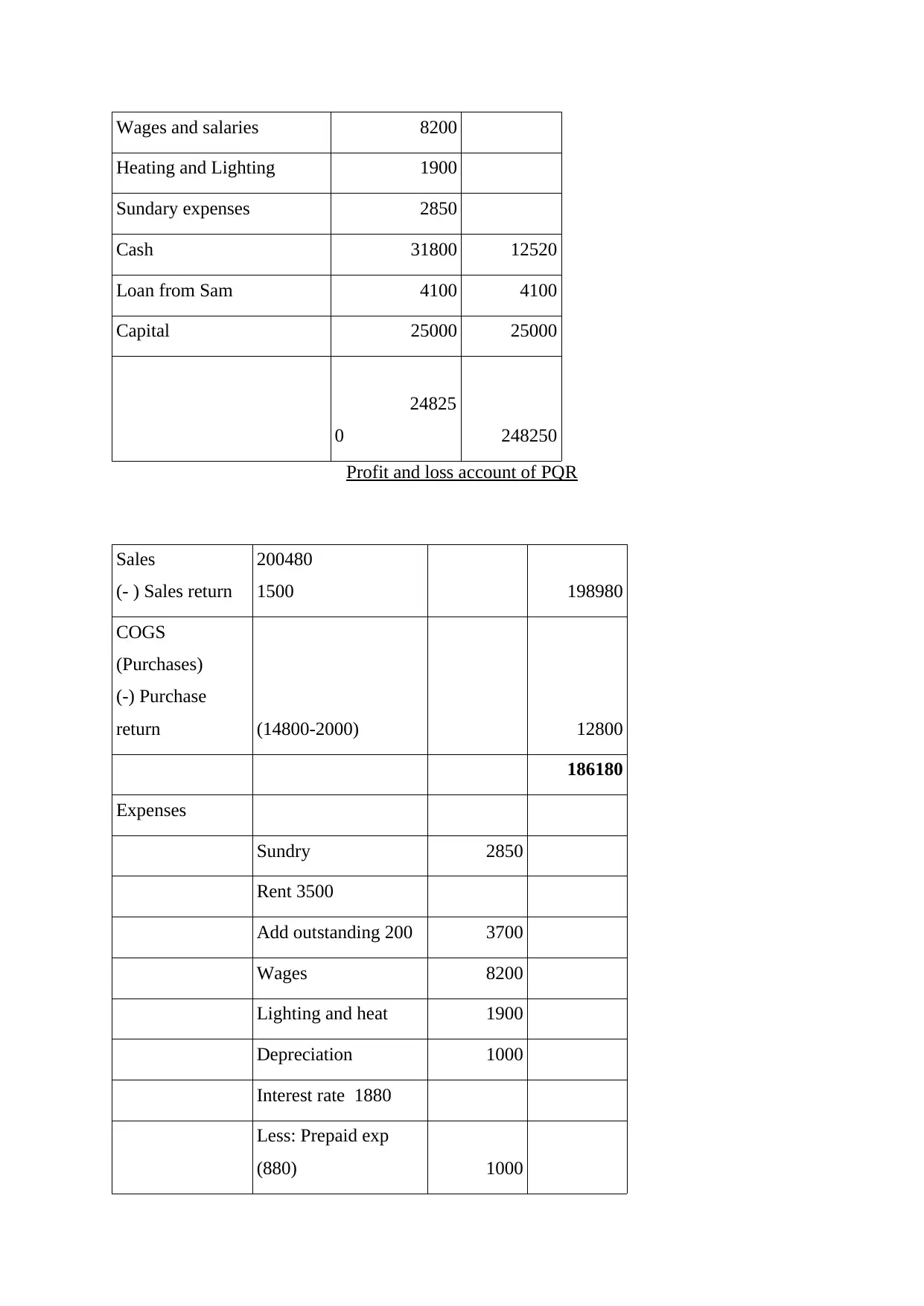
Wages and salaries 8200
Heating and Lighting 1900
Sundary expenses 2850
Cash 31800 12520
Loan from Sam 4100 4100
Capital 25000 25000
24825
0 248250
Profit and loss account of PQR
Sales
(- ) Sales return
200480
1500 198980
COGS
(Purchases)
(-) Purchase
return (14800-2000) 12800
186180
Expenses
Sundry 2850
Rent 3500
Add outstanding 200 3700
Wages 8200
Lighting and heat 1900
Depreciation 1000
Interest rate 1880
Less: Prepaid exp
(880) 1000
Heating and Lighting 1900
Sundary expenses 2850
Cash 31800 12520
Loan from Sam 4100 4100
Capital 25000 25000
24825
0 248250
Profit and loss account of PQR
Sales
(- ) Sales return
200480
1500 198980
COGS
(Purchases)
(-) Purchase
return (14800-2000) 12800
186180
Expenses
Sundry 2850
Rent 3500
Add outstanding 200 3700
Wages 8200
Lighting and heat 1900
Depreciation 1000
Interest rate 1880
Less: Prepaid exp
(880) 1000
Paraphrase This Document
Need a fresh take? Get an instant paraphrase of this document with our AI Paraphraser
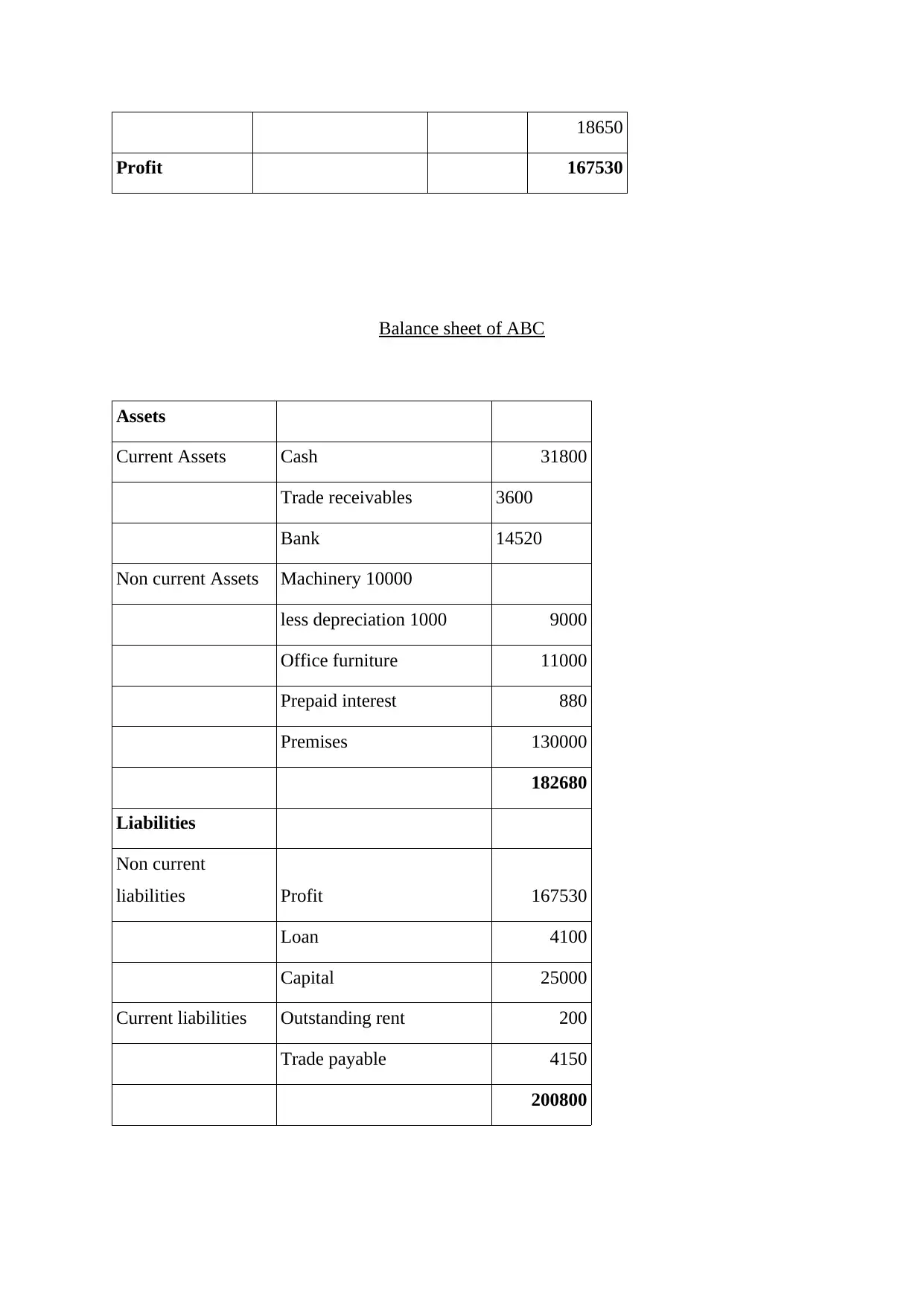
18650
Profit 167530
Balance sheet of ABC
Assets
Current Assets Cash 31800
Trade receivables 3600
Bank 14520
Non current Assets Machinery 10000
less depreciation 1000 9000
Office furniture 11000
Prepaid interest 880
Premises 130000
182680
Liabilities
Non current
liabilities Profit 167530
Loan 4100
Capital 25000
Current liabilities Outstanding rent 200
Trade payable 4150
200800
Profit 167530
Balance sheet of ABC
Assets
Current Assets Cash 31800
Trade receivables 3600
Bank 14520
Non current Assets Machinery 10000
less depreciation 1000 9000
Office furniture 11000
Prepaid interest 880
Premises 130000
182680
Liabilities
Non current
liabilities Profit 167530
Loan 4100
Capital 25000
Current liabilities Outstanding rent 200
Trade payable 4150
200800
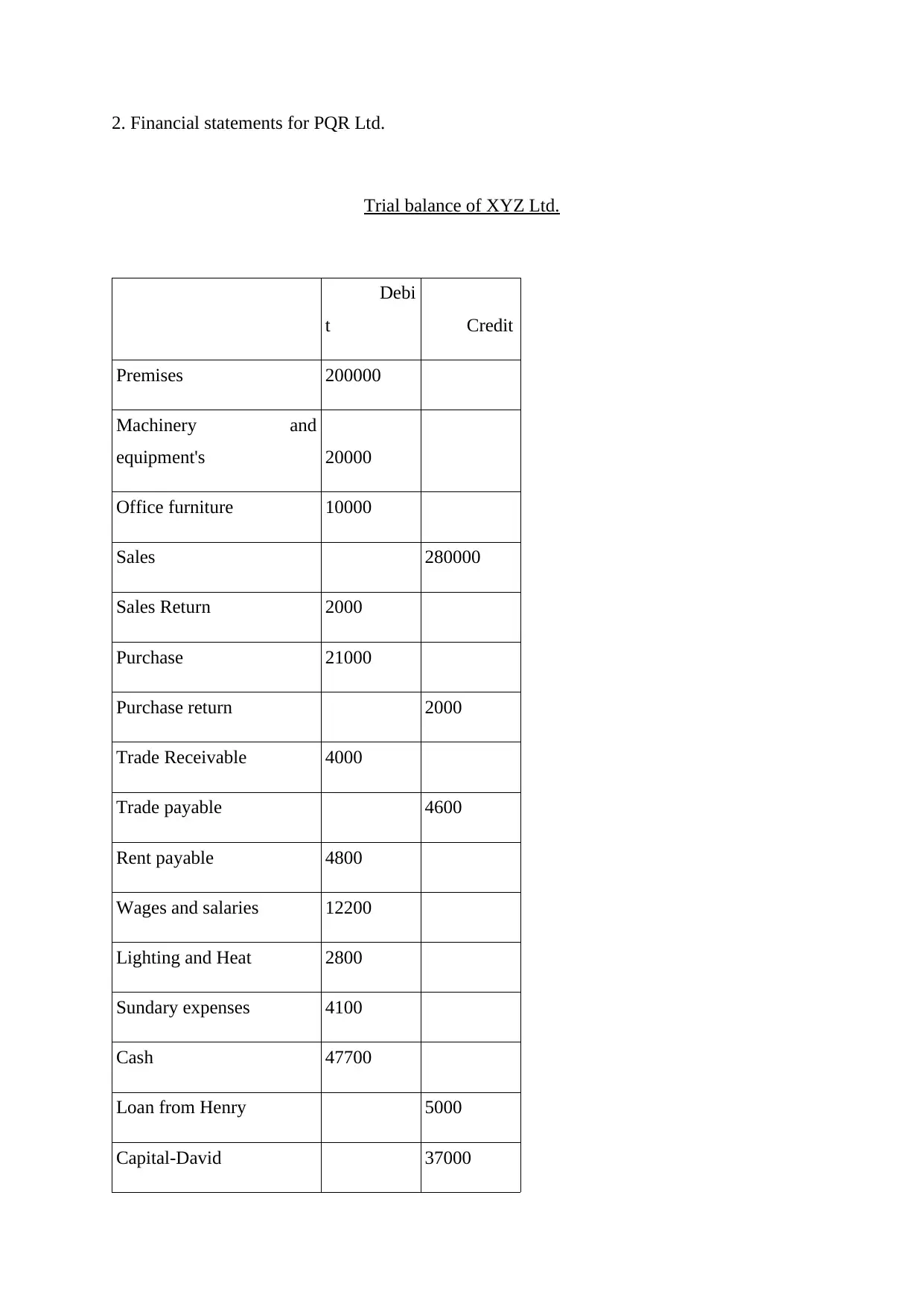
2. Financial statements for PQR Ltd.
Trial balance of XYZ Ltd.
Debi
t Credit
Premises 200000
Machinery and
equipment's 20000
Office furniture 10000
Sales 280000
Sales Return 2000
Purchase 21000
Purchase return 2000
Trade Receivable 4000
Trade payable 4600
Rent payable 4800
Wages and salaries 12200
Lighting and Heat 2800
Sundary expenses 4100
Cash 47700
Loan from Henry 5000
Capital-David 37000
Trial balance of XYZ Ltd.
Debi
t Credit
Premises 200000
Machinery and
equipment's 20000
Office furniture 10000
Sales 280000
Sales Return 2000
Purchase 21000
Purchase return 2000
Trade Receivable 4000
Trade payable 4600
Rent payable 4800
Wages and salaries 12200
Lighting and Heat 2800
Sundary expenses 4100
Cash 47700
Loan from Henry 5000
Capital-David 37000
⊘ This is a preview!⊘
Do you want full access?
Subscribe today to unlock all pages.

Trusted by 1+ million students worldwide
1 out of 23
Related Documents
Your All-in-One AI-Powered Toolkit for Academic Success.
+13062052269
info@desklib.com
Available 24*7 on WhatsApp / Email
![[object Object]](/_next/static/media/star-bottom.7253800d.svg)
Unlock your academic potential
Copyright © 2020–2025 A2Z Services. All Rights Reserved. Developed and managed by ZUCOL.





